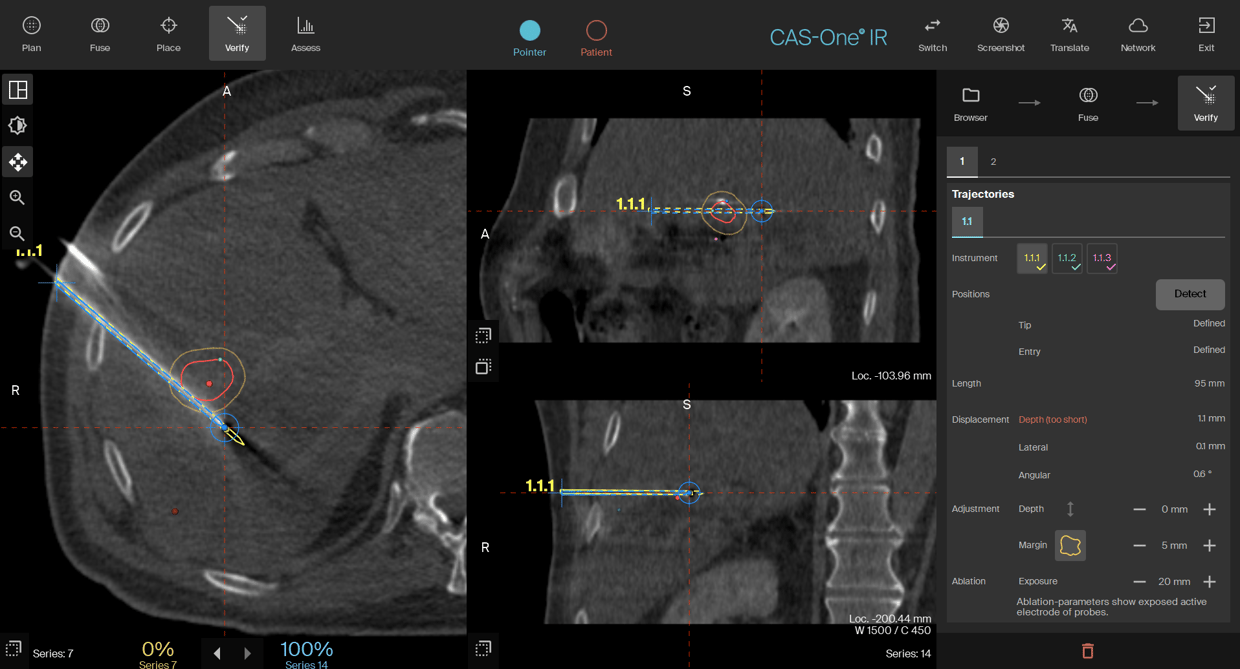Patient treated with IRE and several MWA in the same session
A 59-year-old male, first diagnosed with CRC in 2022, who was, at that point, considered a palliative patient. However, due to good response with chemotherapy, it was later decided to turn the attention to the patient's liver lesions. Knowing the advanced capabilities of CAS-One IR, the tumor board decided for treatment of the liver lesions using IRE for the central lesion and MWA for the other lesions, in the same session. The procedure was performed efficiently, with precision and effectiveness.
 Planning scan focused on the centrally located lesion to be treated with IRE
Planning scan focused on the centrally located lesion to be treated with IRE
 3D reconstruction of the planning scan highlighting the 21mm needle separation for the IRE and 3D model of the liver, hepatic vein and portal vein
3D reconstruction of the planning scan highlighting the 21mm needle separation for the IRE and 3D model of the liver, hepatic vein and portal vein

Needle control scan of all 3 IRE needles with as low as 0.1mm lateral error
Video showing the intricate placement of the IRE needles to miss critical structures and still surround the tumor properly
 AblaSure of the IRE showing sufficient coverage
AblaSure of the IRE showing sufficient coverage
 AblaSure of the MWA showing 100% lesion coverage and sufficient margin coverage
AblaSure of the MWA showing 100% lesion coverage and sufficient margin coverage
Name: Dr. Marie Beermann
Institution: Danderyd Hospital, Stockholm, Sweden
Patient age and sex: Male, 59 years old
- Diagnosed with CRC in 2022, the patient was initially treated with chemotherapy with palliative intent. However, due to a good response, the treatment approach shifted to target the liver metastases
- The initial tumors were identified through MRI, and demonstrated a positive treatment progress
- In July 2024, four new liver metastases were discovered via MRI
- After evaluation, the tumor board determined that the liver metastases could be treated with ablation with CAS-One IR
- Due to the critical location of one lesion in the central part of the liver, non-thermal ablation (IRE) was chosen for that lesion, while MWA was used for the remaining three lesions
- The patient was under general anesthesia, with breathing controlled with high-frequency jet ventilation
- The central liver lesion was addressed first, using three IRE needles positioned around the lesion. The placement was confirmed with a needle verification scan, which showed excellent parallel alignment and high precision.
- Treatment involved 10 test pulses followed by 90 treatment pulses, applied with an increasing energy curve
- Following the IRE procedure, a MW needle was inserted into the lesion in segment VI and ablated for 4 minutes at 100 watts
- Two additional trajectories were then placed in the dorsal region of segment VI, and one in segment III, guided by MRI fusion to target the remaining lesions, which were not visible on CT
- Once all ablations were completed, a contrast-enhanced CT scan was performed to evaluate the results
- The central lesion treated with IRE demonstrated adequate results; however, visualizing the ablation zone effectively can be challenging with this technique therefore a follow up MRI was performed shortly after the treatment
- A follow-up MRI of the patient revealed favorable outcomes from the treatment
- The MWA zone for the lesion in segment VI was assessed using AblaSure, showing complete tumor coverage and full margin coverage
- The additional lesions were also treated with sufficient margins
- CAS-One IR enabled the treatment of four lesions in the same session, utilizing multiple ablation modalities with positive outcomes.
- The ability to accurately plan the placement of IRE needles and automatically detect the separation between them allows the physician to perform IRE treatment with greater confidence.
- A follow-up MRI conducted one month later, showed no tumor progression on the treated lesions


